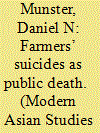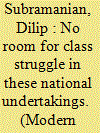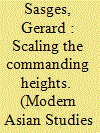|
|
|
Sort Order |
|
|
|
Items / Page
|
|
|
|
|
|
|
| Srl | Item |
| 1 |
ID:
140935


|
|
|
|
|
| Summary/Abstract |
In the late sixteenth and early seventeenth centuries, Jain leaders faced a series of religious questions at the royal Mughal court. At the request of their imperial Muslim hosts, Jain representatives discussed aspects of both Islam and Jainism on separate occasions, including the veracity of Islam, whether Jains are monotheists, and the validity of Jain asceticism. The Mughals sometimes initiated these conversations of their own accord and at other times acted on the prompting of Brahmans, who had political and religious interests at stake in encouraging imperial clashes with Jain leaders. Jain authors recorded these exchanges in numerous Sanskrit texts, which generally remain unknown to Mughal historians and Sanskrit scholars alike. I examine the Jain accounts of these cross-cultural debates and expound their political, religious, and intellectual implications. These engagements showcase how the Mughals negotiated religious differences with diverse communities in their kingdom. Furthermore, the Sanskrit narratives of these dialogues outline complex theological visions of how Jain beliefs and practices could thrive within a potentially hazardous Islamicate imperial order. More broadly Jain and Mughal discussions provide rich insight into key developments in religious precepts and local identities in early modern India.
|
|
|
|
|
|
|
|
|
|
|
|
|
|
|
|
| 2 |
ID:
140942


|
|
|
|
|
| Summary/Abstract |
his paper argues that Indian farmers’ suicides may fruitfully be described as public deaths. Based on ethnographic fieldwork in the South Indian district of Wayanad (Kerala), it shows that farmers’ suicides become ‘public deaths’ only via the enumerative and statistical practices of the Indian state and their scandalization in the media. The political nature of suicide as public death thus depends entirely on suicide rates and their production by the state itself. But the power of representations complicates the ethnographic critique of statistical knowledge about suicide. In a context like Wayanad, which had been declared a suicide-prone district by the Indian state, public representations of suicides have taken on a life of their own; statistical categories and the media interpretations of these statistics have had a curious feedback—mediated by development encounters—onto the situated meanings of individual suicides. Local interpretations of individual suicides mostly commented on personal failures of the suicide and on the perils of speculative smallholder agriculture. Ethnography of farmers’ suicide based on case studies alone, however, would soon encounter limitations equally grave as the limitations of statistical analysis. Not only is the meaning of suicide (intentions, causes, motives) at the actor level off limits for ethnography, but in addition to that the (public) meaning of suicide is co-determined by state practice including statistical accounting.
|
|
|
|
|
|
|
|
|
|
|
|
|
|
|
|
| 3 |
ID:
140936


|
|
|
|
|
| Summary/Abstract |
This article analyses representations of the indentured woman in the Hindi print-public sphere of colonial north India in the early twentieth century. There have been sophisticated studies on the condition of Indian women in the plantation colonies of the British Empire, this article focuses instead on the vernacular world within India, showing how the transnational movements of these women emigrants led to animated discussions, in which they came to be constructed as both innocent victims and guilty migrants, insiders and outsiders. The ways in which these mobile women came to be represented reveal significant intersections between nation, gender, caste, sexuality, and morality. It also demonstrates how middle-class Indian women attempted to establish bonds of diasporic sisterhood with low-caste indentured women, bonds that were also deeply hierarchical. In addition, the article attempts to grasp the subjective experiences of Dalit migrant, and potentially migrant, women themselves, and illustrates their ambivalences of identity in particularly gendered ways.
|
|
|
|
|
|
|
|
|
|
|
|
|
|
|
|
| 4 |
ID:
140938


|
|
|
|
|
| Summary/Abstract |
Flood protection in the Brahmaputra's floodplains began rather late and was implemented precisely to protect the important commercial crop of jute. To begin with, in the early twentieth century, after a long wait and much speculation, action was finally taken to make the Brahmaputra's floodplains more productive to the British Empire. Soon the commercial production of jute began in the floodplains. This article explains how the Brahmaputra's floodplains were converted into the British empire's eastern-most jute frontier. The article also explains the political economy of flood management in Assam in the second half of the twentieth century. Further, explaining the shifting relations between state, capital, and floodplain, the article shows how these schemes achieved only partial success and at the cost irreversible ecological damage.
|
|
|
|
|
|
|
|
|
|
|
|
|
|
|
|
| 5 |
ID:
140941


|
|
|
|
|
| Summary/Abstract |
Independent India's new state-owned infrastructural industries were not only entrusted with the mission of producing essential public commodities, but they were also required to promote the economic and social advancement of their workforces. To achieve this objective, big public enterprises in particular, helped by the financial power they derived from their control over the strategic sectors of the domestic economy, established generously endowed welfare programmes. This article argues that such a developmental ideology shaping managerial policy orientations is central to understanding why accepted explanations for the rationale of employer-sponsored social benefits are insufficient when it comes to studying similar initiatives in the Indian public sector. To substantiate its argument, the article explores the provisioning of social needs over a period of roughly half a century (1948–2002) at a large state-run producer of telecommunications equipment, Indian Telephone Industries. The welfare regime as it evolved here boasted one unique feature: it rested on dual foundations, with both the company and the trade union assuming independent responsibility for the well-being of employees. A range of informal self-help schemes devised by workers further supplemented the institutionalized social security net set up by the management and the union. The article also discusses how the firm sought to scale back its largesse in the aftermath of economic liberalization.
|
|
|
|
|
|
|
|
|
|
|
|
|
|
|
|
| 6 |
ID:
140940


|
|
|
|
|
| Summary/Abstract |
By the late 1800s the colonial state's increasing capacity to regulate, finance, and tax had begun to open up new opportunities for locally based French enterprises in Indochina. Chinese syndicates that had previously dominated the economy found themselves deprived of existing revenue streams and denied access to new ones. The result was an ‘Indochinese moment’ when a handful of colonial conglomerates used profits from state contracts, monopolies, and subsidies as a base for growth and diversification after 1900. Yet scaling the commanding heights of the economy was not easy, and was only achieved thanks to sustained and powerful state intervention. Moreover, one of the effects of the economic crisis after 1928 was the end of this Indochinese moment and a shift in initiative to a new partnership that linked an increasingly technocratic state with the financiers and experts of the Bank of Indochina. This article investigates this complex interaction of state power, technology, and capital flows with local Chinese, French, and indigenous Indochinese actors, using one particular conglomerate, the Fontaine group, as a case study to shed light on the mechanisms that linked an interventionist state to capitalist enterprise and ultimately to the remaking of the Indochinese economy.
|
|
|
|
|
|
|
|
|
|
|
|
|
|
|
|
| 7 |
ID:
140937


|
|
|
|
|
| Summary/Abstract |
The chief concern of this article is the organization and administration of rural policing in colonial Bengal during the last 40 years of the nineteenth century. It connects its design and implementation with the consolidation of India's colonial police force, while highlighting the ongoing negotiations made by the Bengal police in a wider colonial model. The article argues that the police administration of rural Bengal was shaped initially by the ordinary constraints of the colonial state which underpinned the design of the Indian police—namely its frugality and preference for collaborating with local intermediaries, a manifestation of salutary neglect. Yet, it highlights the role of Bengal's largely British police executive in renegotiating customs of governance and, ultimately, as an established model of policing in India. The article focuses, therefore, on ongoing and at times informal police reforms which were based upon notions contradictory to an official discourse about policing in India. This article thus contextualizes the development of rural police administration in Bengal in a strong tradition of police-led reform in the province. In so doing, the article redresses a traditional historiographical focus on the political origins and coercive function of the police, and problematizes current research which situates Indian policing within customs of British governance in the subcontinent.
|
|
|
|
|
|
|
|
|
|
|
|
|
|
|
|
| 8 |
ID:
140939


|
|
|
|
|
| Summary/Abstract |
Before the 1937 Japanese invasion of China, almost all Chinese leaders and intellectuals believed that the large-scale agricultural settlement of China's western peripheries would rapidly deliver extensive economic and social benefits. At the onset of the war, many officials from the western provinces pressed the central government to fund programmes to allow millions of refugees from Japanese-occupied territory to settle on and cultivate ‘wasteland’ (huang) on the peripheries of their jurisdictions. Influenced more by pre-War ideology than the demands of the War, central and provincial governments established ‘land settlement and cultivation zones’ (kenzhiqu) in these provinces. However, these ventures were much less well supported than their proponents had hoped. This was not only because the War strained government finances—funding for kenzhiqu was always limited relative to support for agricultural cooperatives—but also partly because kenzhiqu attempts to recruit settlers clashed with the acute labour shortage in core zones of unoccupied China, which led to the abandonment of already cultivated land there, and partly because of the mistrust between central and regional governments. Nonetheless, wartime advocacy for more land cultivation in the Northwest did have important repercussions, leading to a renewed interest in penal colonies.
|
|
|
|
|
|
|
|
|
|
|
|
|
|
|
|
|
|
|
|
|